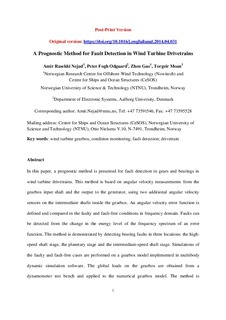| dc.contributor.author | Rasekhi Nejad, Amir | |
| dc.contributor.author | Odgaard, Peter Fogh | |
| dc.contributor.author | Gao, Zhen | |
| dc.contributor.author | Moan, Torgeir | |
| dc.date.accessioned | 2017-12-28T12:10:48Z | |
| dc.date.available | 2017-12-28T12:10:48Z | |
| dc.date.created | 2014-05-12T13:28:05Z | |
| dc.date.issued | 2014 | |
| dc.identifier.citation | Engineering Failure Analysis. 2014, 42, 324-336. | nb_NO |
| dc.identifier.issn | 1350-6307 | |
| dc.identifier.uri | http://hdl.handle.net/11250/2473820 | |
| dc.description.abstract | In this paper, a prognostic method is presented for fault detection in gears and bearings in wind turbine drivetrains. This method is based on angular velocity measurements from the gearbox input shaft and the output to the generator, using two additional angular velocity sensors on the intermediate shafts inside the gearbox. An angular velocity error function is defined and compared in the faulty and fault-free conditions in frequency domain. Faults can be detected from the change in the energy level of the frequency spectrum of an error function. The method is demonstrated by detecting bearing faults in three locations: the high-speed shaft stage, the planetary stage and the intermediate-speed shaft stage. Simulations of the faulty and fault-free cases are performed on a gearbox model implemented in multibody dynamic simulation software. The global loads on the gearbox are obtained from a dynamometer test bench and applied to the numerical gearbox model. The method is exemplified using a 750 kW wind turbine gearbox. The case study results show that defects in the high- and intermediate-speed bearings can be detected using this method. It is shown that this procedure is relatively simple, yet accurate enough for early fault detection in wind turbine gearboxes. | nb_NO |
| dc.language.iso | eng | nb_NO |
| dc.publisher | Elsevier | nb_NO |
| dc.rights | Attribution-NonCommercial-NoDerivatives 4.0 Internasjonal | * |
| dc.rights.uri | http://creativecommons.org/licenses/by-nc-nd/4.0/deed.no | * |
| dc.title | A prognostic method for fault detection in wind turbine drivetrains | nb_NO |
| dc.type | Journal article | nb_NO |
| dc.type | Peer reviewed | nb_NO |
| dc.description.version | acceptedVersion | nb_NO |
| dc.source.pagenumber | 324-336 | nb_NO |
| dc.source.volume | 42 | nb_NO |
| dc.source.journal | Engineering Failure Analysis | nb_NO |
| dc.identifier.doi | 10.1016/j.engfailanal.2014.04.031 | |
| dc.identifier.cristin | 1132331 | |
| dc.relation.project | Norges forskningsråd: 193823 | nb_NO |
| dc.description.localcode | Copyright © 2014 Elsevier Ltd. All rights reserved. This is the authors' accepted and refereed manuscript to the article. | nb_NO |
| cristin.unitcode | 194,64,20,0 | |
| cristin.unitname | Institutt for marin teknikk | |
| cristin.ispublished | true | |
| cristin.fulltext | postprint | |
| cristin.qualitycode | 1 | |

